Living Now
Lifetime achievement award goes to Chinese label industry’s founding father
Young people are the future of the sign industry in the UK
HP to showcase new business growth opportunities at photokina 2016
VersaUV Experience Day by Roland DG was successful
Music
Van Morrison Biography
Do you remember when we used to sing, Sha la la la la la la la la la la te da This 68…Neil Sedaka Biography.
The Little Devil that was brought down and found Waking Up Hard to Do. This American…List of UK Singles Chart Christmas number ones from 2014-1952
List of UK Singles Chart Christmas number ones from 2014-1952Biography of Tom Jones
A boy from nowhere still going strong. Pontypridd is not a place that springs to mind…Elmore James (1918-1963)
One of my favourite Blues artists of all time Mr Elmore James was born on January 27,…Cat Stevens - Yusuf Islam Biography
“You can argue with a philosopher, but you can’t argue with a good song”. This 65 year…The Beatles Biography 1970-2013 Part 4 of 4
The Long and Winding Road after Breakup The Beatles 1970-2013 Part 4 of 4 Part 1 can be…The Beatles Biography 1970-2013 Part 3 of 4
The Long and Winding Road after Breakup Part 3 or 4 This is part 3 of a 4 part series on…
Events
Absolute Graphics A Winner
New T3 Affinity display system proves an ‘absolute winner’ for Irish company. One of the…Mimaki UJV55-320 To ‘WoW’ Visitors At Sign & Digital UK
New 3.2m Mimaki UJV55-320 to be put through its paces at exhibition launch. UK based,…Sign & Digital UK 2016 Expands Business Theatre
New seminars will cover interior wall décor, wayfinding and directional signage. Sign &…New Affordable Roll-To-Roll Printer From Mimaki
New UJV55-320 3.2m UV printer expands grand format graphics opportunities. A new, 3.2m…Roland DG returning to Sign & Digital UK 2016
Latest and greatest technology being brought to Sign & Digital UK 2016 Roland DG has…Kiian Digital To Launch Digistar K-Choice At ITMA 2015
Designed for Kyocera print heads and to meet textile Industry standards. Italian based…Antalis Keeps On The Education Trail
Company continues regional educational workshops for printers. Antalis UK has confirmed…Arjowiggins Creative Papers-Mohawk alliance
Antalis offers new business opportunities to digital printers following ground-breaking…
Arts & Entertainment
Lifetime achievement award goes to Chinese label industry’s founding father
Young people are the future of the sign industry in the UK
HP to showcase new business growth opportunities at photokina 2016
VersaUV Experience Day by Roland DG was successful
First Appearance Of MTEX 5032HS In UK
IDS Wins Red Dot Award
Life & Style
Xerox is splitting their company in two.
Soyang Europe Strengthens Sales Team
Burns To Chair New Xerox Company
IIJ Beefs-Up Technical Support
New Technical Service Engineer At Durst UK
Brother Goes Outside ‘The Box’
- Details
- Written by Administrator
- Parent Category: Life and Style
- Category: Personal Development
My Allotments.
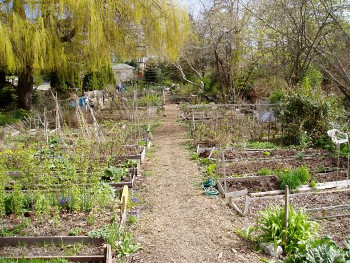 The reason I have allotments is quite simple really. I love growing my own vegetable and eating fresh and healthy food. This year has been a difficult year for many reasons. Firstly we took on a second allotment which required a lot of work and secondly, the weather has been so bad that crops have not grown and yields are very much reduced.
The reason I have allotments is quite simple really. I love growing my own vegetable and eating fresh and healthy food. This year has been a difficult year for many reasons. Firstly we took on a second allotment which required a lot of work and secondly, the weather has been so bad that crops have not grown and yields are very much reduced.
The beginning of the year is very much preparation time and having a rotavator has really made such a big difference. For one thing I do not have such an aching back anymore and the time to prepare the ground has halved. Also the quality of the ground is far improved because I can get a really fine tilth which makes raking and planting so much easier. This has also meant that work on the second allotment has been easier for the exact same reason. In fact the rotavator has really paid for itself in the first year and I have even hired myself out to fellow allotmenteers to work on their allotments.
Our original allotment has not been too bad in many respects. The over wintered onions and garlic were quite good although the garlic was quite small. In the onion crop we had some reasonably large ones. The potatoes were disappointing and although the weather was not that conducive to blight, it was certainly present. The harvest from them was slightly down on previous years and this year we tried some different varieties with mixed results. With most of our other crops the yields were definitely low and in some cases positively dreadful. The reason for this was the fact that we had a very early and very short summer which arrived in March with the rest of the official summer being either dull or wet and cold. Our peas and bean harvest was especially disappointing considering we had such a good crop the previous year. Talking to many of my fellow allotmenteers I discovered that we were all having similar problems with our carrots which many of us could not get them to grow; in fact having just harvested my remaining carrots the yield and size are well below what I would normally achieve. The salad crops this year also suffered from the weather and although the harvest was reasonable it was definitely down on previous years. One crop that did do well was my Shallots and I have pickled more than other years.
Having taken on a second allotment we made the decision to use it mainly for fruit and so we looked at buying a fruit cage (to keep the birds out, we grow the fruit for us not them). Having looked at the ridiculous prices of them I said I can make one for much less. We acquired some old scaffold boards from the previous owner and bought some more. We also purchased wood for the frame and other bits and pieces to hold it together. As we built the base I said I am not going to cut scaffold boards by hand so it ended up wider and longer than originally planned, a blessing really because it meant we can get more in to it. We then constructed the frame over a few weekends and alongside it we built a raised bed for strawberries. Around about Easter my eighty eight year old father came to visit us and I asked him if he would help us put up the netting which he did so very willingly, and thoroughly enjoyed himself. After he had gone back we then put on the netting on the top and planted it up. We had inherited blackcurrants, red and white currants and gooseberries as well as raspberries. Some of our friends also gave us some raspberry plants and we bought a few more. Something else which we inherited from the previous owner was Rhubarb plants which did very well and will remain where they are as they have established themselves. We planted up the strawberry bed and did not buy a single plant as we found over thirty on the allotment and the yield was very good considering that they were moved. We did not move the inherited fruit bushes initially as they were budding; some of the blackcurrants and gooseberries have been moved into the fruit cage now. One plant that has done exceptionally well this year is the raspberry we were picking until a couple of weeks ago. We have put aside an area for herbs and we are growing the usual mint, thyme, sage lemon balm and several others which I cannot remember. I am also growing horseradish; this can be quite invasive and so it is recommended to grow in through a pot in the ground. This is done by taking a plastic flower pot and cutting the bottom out and digging a hole in the ground and placing the pot in it and planting the root and covering it over. Growing Horseradish is a two year job and it dies back in the winter. I have two roots in as I did not realise the previous owner had some planted. Now I have harvested a few of the stray roots and made my own horseradish sauce and as they said in the recipe it is very strong when you peel it, even stronger than onions (they are not wrong). But the taste is something else, and I cannot wait to make more. We also grew potatoes on the new allotment and they did quite well.
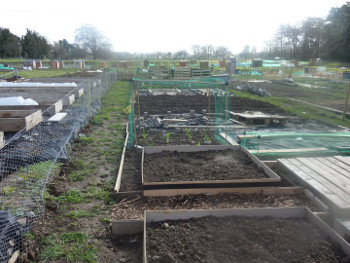 Regarding plans for next year well we intend to keep both allotments; why, because it is so different from what I do in the daytime and it is exercise and fresh air. Also the food tastes so good and there is the sense of achievement of having grown this yourself. Many of the fruit bushes have been moved into the fruit cage and are starting to bud already. We have to take out some raspberries and replace them with ones from home and also from around the edge of the allotment. There is a paved area at the back and I want to take it up and move it to the other allotment and make a paved sitting area in front of the shed, I am looking at planting a couple of apple trees in large tubs and sinking them into the ground to grow so that I can have my own cooking apples. At the moment we are preparing for winter by digging in some green manure as well as skimming off the weeds and covering them with weed suppressant to be followed by old carpet towards the end of February to start to warm the ground up. There are few upgrades to the fruit cage to be done and also we have to finish off putting in the bark pathway and then moving some baby box bushes to give more growing space. I shall also be moving the slabs and re-laying them on our original allotment. So it is going to be a busy winter and from early January seeds will be planted and the dining room table will become a seed nursery. But before then it is now time to draw up the proposed plan for both allotments for next year. All this means is that we can follow a good crop rotation and ensure that we do not grow the same thing in the same place every year.
Regarding plans for next year well we intend to keep both allotments; why, because it is so different from what I do in the daytime and it is exercise and fresh air. Also the food tastes so good and there is the sense of achievement of having grown this yourself. Many of the fruit bushes have been moved into the fruit cage and are starting to bud already. We have to take out some raspberries and replace them with ones from home and also from around the edge of the allotment. There is a paved area at the back and I want to take it up and move it to the other allotment and make a paved sitting area in front of the shed, I am looking at planting a couple of apple trees in large tubs and sinking them into the ground to grow so that I can have my own cooking apples. At the moment we are preparing for winter by digging in some green manure as well as skimming off the weeds and covering them with weed suppressant to be followed by old carpet towards the end of February to start to warm the ground up. There are few upgrades to the fruit cage to be done and also we have to finish off putting in the bark pathway and then moving some baby box bushes to give more growing space. I shall also be moving the slabs and re-laying them on our original allotment. So it is going to be a busy winter and from early January seeds will be planted and the dining room table will become a seed nursery. But before then it is now time to draw up the proposed plan for both allotments for next year. All this means is that we can follow a good crop rotation and ensure that we do not grow the same thing in the same place every year.
My allotments are a place for me to relax, unwind, get exercise, fresh air in the knowledge I am growing my own vegetables and fruit, enjoying the great taste and also making some money out of it.
Adrian Rush MISTC
Managing Partner
AMR Enterprises
Mobile - +353 (0)87 677 3631
E-mail – This email address is being protected from spambots. You need JavaScript enabled to view it." mce_' + path + '\'' + prefix + ':' + addy65252 + '\'>'+addy_text65252+'<\/a>';
//-->
Copyright © 2012, DPNLIVE – All Rights Reserved
- Details
- Written by Administrator
- Parent Category: Life and Style
- Category: Personal Development
“IrelandONE to IrelandWON”
is the cornerstone of the conference.
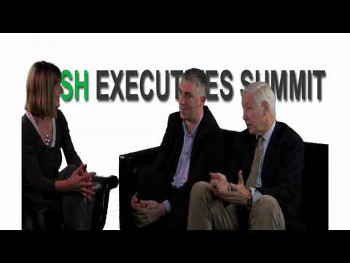 Irish ExecutivesThe Irish Executive Network, Ireland’s largest global social media network for business leaders, has announced that it will host its second annual global summit at the Radisson Blu Hotel in Galway on September 26th and 27th, 2012. Some of the core themes of the event are centred on leadership, networking and driving innovation, all designed to get Irish business moving again with its motto to ‘drive cross-border collaboration to ensure Ireland’s future success’.
Irish ExecutivesThe Irish Executive Network, Ireland’s largest global social media network for business leaders, has announced that it will host its second annual global summit at the Radisson Blu Hotel in Galway on September 26th and 27th, 2012. Some of the core themes of the event are centred on leadership, networking and driving innovation, all designed to get Irish business moving again with its motto to ‘drive cross-border collaboration to ensure Ireland’s future success’.
Organisers said that the key topics which will be covered at the event range from leadership to innovation in product, service and process and thought leadership in health and wellness. Over the two-day event the conference is expected to draw approximately 300-400 from the global Irish Diaspora.
Read more: Irish Executive Network to Host 2nd Annual Global Summit
- Details
- Written by Dallas A Dixon
- Parent Category: Life and Style
- Category: Personal Development
A Man & His First Car!
Dallas A. Dixon BIO
After graduating from high school in Grundy Center, Iowa, in 1961, Dallas spent four years in the U.S. Navy, including three years aboard the submarine USS Bang. With an Honourable Discharge in hand, Dallas returned to Iowa and found employment by working at the lowest position on a land survey crew. Dallas married Rita and they eventually became the parents of two daughters. In 1985, after the further education of hard knocks and several thousand hours of home study, Dallas had the privilege of becoming licensed as a Professional Land Surveyor in the State of Iowa. Dallas retired in 1999. Dallas and Rita reside in Waterloo, Iowa. By the fall of 2011, Dallas had written and published 2 books. He is currently contemplating (part-time) another book.
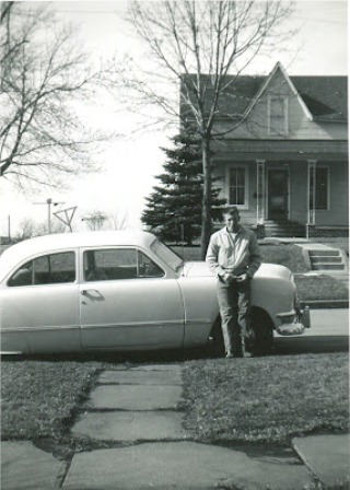 D-Dixon-my-carIn the spring of 1959, about 6 months before my seventeenth birthday, I asked my parents if I could buy a car. Mom remained silent, but Dad quickly asked, “Do you have enough money to buy a car?” “I believe so,” I replied. “Do you have enough money to pay for car insurance and license plates?” asked Dad with a smile. “You will also need enough money for gas, oil, maintenance, etc.” “I have been working and saving my money since I was twelve,” I replied, “and as you know, I work at the Standard Oil Station 3 or 4 nights a week as well as several hours during the weekends. I earn a dollar an hour, so I should be able to afford a car, at least a very old car.” “Okay, then,” Dad replied. “If you think you can afford a car, I will be glad to help you shop for one.”
D-Dixon-my-carIn the spring of 1959, about 6 months before my seventeenth birthday, I asked my parents if I could buy a car. Mom remained silent, but Dad quickly asked, “Do you have enough money to buy a car?” “I believe so,” I replied. “Do you have enough money to pay for car insurance and license plates?” asked Dad with a smile. “You will also need enough money for gas, oil, maintenance, etc.” “I have been working and saving my money since I was twelve,” I replied, “and as you know, I work at the Standard Oil Station 3 or 4 nights a week as well as several hours during the weekends. I earn a dollar an hour, so I should be able to afford a car, at least a very old car.” “Okay, then,” Dad replied. “If you think you can afford a car, I will be glad to help you shop for one.”
A few days later, Dad and I went to Cedar Falls, Iowa. After visiting a few car dealerships and looking at several used cars, I selected a 1950 Ford, even though it had some rusted out holes in the rear fenders, front fenders, and underneath the doors, but it was within my budget of 200 dollars. The car contained a 95 horsepower, I-6 flat-head engine and a 3 speed manual transmission with overdrive. The car did not have power steering or power brakes, but sported an AM radio. I felt nearly ecstatic as I drove my first car from Cedar Falls to Grundy Center, all the while thinking, Wow! Owning my very own car is really great.
About a month later, the engine began missing and sputtering, running very roughly, so I drove the car to Wilbur’s house one evening and asked Wilbur, one of my neighbors, if he could tell me what was wrong with the engine. Wilbur worked as a mechanic at the local GM dealership, so it did not take him long to inform me that the car engine needed a valve job. He said that if I was going to do that, I might as well overhaul the entire engine. I asked Wilbur how much an overhaul would cost. He gave me an estimated price, and I quickly replied that I could not afford to pay that much money. Then, he said that if I were willing to do all the labor, it would cut the cost by more than half. I replied that I would do the labor, so Wilbur said that he would ask his boss, the GM dealership owner, if I could dismantle the Ford inside of the GM garage. Wilbur said that I could use all his tools and said that he would instruct me on how to do everything. The next day, Wilbur told me that his boss had agreed, so I asked Bill, one of my friends and neighbors, if he would help me with the Ford. Bill agreed to help me, so a few days later we took the Ford uptown to the GM garage and began removing parts from the Ford. Our good neighbor, Wilbur, worked on other car engines, but paused long enough to instruct Bill and me as we slowly removed the radiator and other parts so that we could remove the Ford’s engine. Two weeks later, my Ford contained a newly overhauled engine, and a new clutch. Fortunately, I only had to pay for the parts, which saved a lot of money. I thanked Wilbur, Bill, and the owner of the GM dealership many times before I drove the car out of the garage.
My money seemed to be disappearing faster since I had purchased the car, so I found another job working part-time at a very small Texaco gas station during the nights and weekends when I did not work at the Standard Oil Station. The car was mechanically sound after the overhaul, but needed substantial bodywork, so I approached Glen, the owner of a local body shop, and asked him if he needed any part-time help. Glen said that he had been looking for someone to work part-time, but he wanted someone who was an adult, not a kid my age. We talked for a while and after Glen looked at my Ford, he said that perhaps I could work for him when he needed the help, and then in my spare time I could do the bodywork on my Ford. Glen offered to pay one dollar an hour for my labor, and said that he would sell me the parts and materials for my car at his cost. I thought that sounded fair, so I began working at the body shop six days a week. Over the next few months, I spent many hours doing bodywork, mostly wet-sanding and masking cars so that Glen could paint them. I also spent many hours doing bodywork on my Ford, including customizing it, and shortly before I began my senior year in high school, Glen spray-painted my Ford with two coats of beautiful light-green enamel paint. When I began my senior year of high school, I could only work at the body shop during after school hours and on Saturdays. I occasionally played hooky from my senior year of school, so that I could work at the body shop. I learned a few years later that I should have stayed in class and made more of an effort in high school while I had the chance. I continued working at both gas stations during my senior year, but only on nights and Sundays, because I worked almost every Saturday at the body shop.
My customized Ford appeared very sharp with the new, light-green paint job. At about 9 p.m. one Saturday, not long after my seventeenth birthday, I parked my Ford on the street in front of my friend’s home and went with him and his father on their rural milk route to help them collect fresh milk from dairy farmers. We finished the route three hours later and as we arrived next to my car, I noticed what appeared to be steam exiting through the Ford’s partially opened side-windows. At first, I thought it was from humidity, but as soon as I opened the front car door, the backseat burst into flames. My friend’s father, who also worked as a volunteer firefighter, jumped into the car, removed the backseat, and threw it onto the street. The backseat had a two feet diameter hole burned into it. Then, I remembered that I had thrown a cigarette out of the open front window just before I had parked the car. The cigarette must have blown back into the car and landed on the backseat. I called the insurance man the following Monday and after he inspected the car, he offered to total the car and pay me a hundred dollars.
After Dad and I argued with the insurance agent for a while, he agreed to pay me a hundred dollars and said that I could keep the car. I spent the next three months completely redoing the Ford’s interior. I purchased used seats and door panels at a local junkyard, but bought a brand-new headliner. The hardest part was scrubbing the Ford’s interior, trying to get the smell of burning upholstery to disappear. By the spring of 1961, I had the entire interior finished and it appeared immaculate.
I left home for the US Navy in May of 1961, but the Ford remained at my parents' property until sometime in 1964 when I asked Dad during a phone call if he would sell the car for me. I was overseas when Dad sold the Ford. I did not see that Ford again until one day in the mid-1990s when I was working with a land survey crew in downtown Waterloo. I noticed a Ford parked inside an automobile restoration shop, so I took a few minutes off from surveying to look at the Ford, and soon discovered it to be the same 1950 Ford. To this day, I am very careful about extinguishing my cigarettes in the ashtray instead of throwing them out through the open car window. The best part is that I learned a lot about bodywork and mechanical work during the time I owned the Ford, and that helped me save a lot of money through the years as I worked on other cars I owned.
By Dallas A. Dixon
E-mail: This email address is being protected from spambots. You need JavaScript enabled to view it." mce_' + path + '\'' + prefix + ':' + addy26290 + '\'>'+addy_text26290+'<\/a>';
//-->
- Details
- Written by Doug Young
- Parent Category: Life and Style
- Category: Personal Development
By Doug Young
As the days Cindy and I had remaining in Việt Nam were winding down in the late spring of 2006; two students were regulars at our apartment. Tuan was a tall good-looking young man with a science degree and the desire to earn a PhD. Trang was an uncommonly outgoing young lady I’d first met in my American Culture class. She was an honors student who wrote a research paper in lieu of final exams during her final year. I was flattered when she asked me to be her academic advisor.
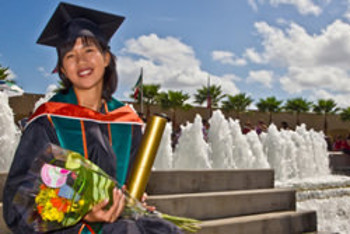 Trang-GraduationThey came over to help us pack up for the trip home. Trang chatted amiably with Cindy as they wrapped carved wooden models of xích lô (pedicabs, similar to rickshaws), vases, embroideries and other gifts given to us by our Vietnamese friends. Tuan helped me cram things into a large wooden crate built to ship our new prizes home. Conversation drifted to what Tuan and Trang would do after graduation. Tuan looked into studying in the Netherlands, but really wanted to go to the US. Trang wanted a job for awhile, but she too eventually wanted to study in America. A glance between Cindy and me cemented that idea that we would do what was needed to get these kids into graduate school in America.
Trang-GraduationThey came over to help us pack up for the trip home. Trang chatted amiably with Cindy as they wrapped carved wooden models of xích lô (pedicabs, similar to rickshaws), vases, embroideries and other gifts given to us by our Vietnamese friends. Tuan helped me cram things into a large wooden crate built to ship our new prizes home. Conversation drifted to what Tuan and Trang would do after graduation. Tuan looked into studying in the Netherlands, but really wanted to go to the US. Trang wanted a job for awhile, but she too eventually wanted to study in America. A glance between Cindy and me cemented that idea that we would do what was needed to get these kids into graduate school in America.
With a strange mix of feelings - eager to go home yet terribly reluctant to leave a city we knew well, with its coterie of friends and stimulating daily life - we left Việt Nam. Within seven months, I was back for my first visit. In fact, we made three trips back in 2007. Trang had moved to Sài Gòn where she worked for IBM. (Yes - the locals still call it Sài Gòn, despite the official name of Hồ Chí Minh City.) Tuan was back in school working on his Master’s degree at the University of Huế - and both kept talking about studying overseas, but neither could figure out how to do it.
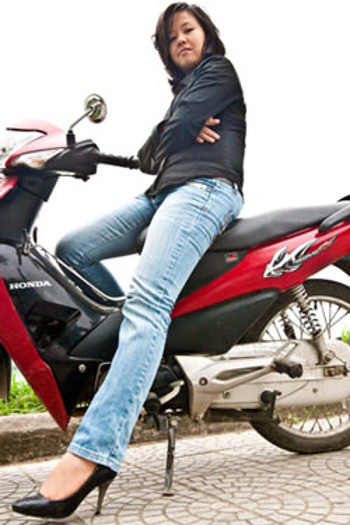 Ai Nhan MotorbikeIn the fall of 2008, we were once again in Sài Gòn. Trang joined us for dinner, then the three of us headed off to the hotel room where Cindy and I were staying. It was time to put plans in action.
Ai Nhan MotorbikeIn the fall of 2008, we were once again in Sài Gòn. Trang joined us for dinner, then the three of us headed off to the hotel room where Cindy and I were staying. It was time to put plans in action.
There is an indelible picture in my mind - a picture I wish I had taken with a camera. After Cindy and I laid out the details, Trang sat quietly in her chair, not saying a word. I had carefully laid out the plans that would have Trang work as a graduate assistant at a university. That would give her much lower tuition rates and she could pay for her own food and lodging. Cindy and I would pay her tuition and books.
But Trang sat there - very quiet. Cindy and I exchanged anxious glances.
“Are you alright, Trang?”
“Yes. I am okay.” But she still did not look up.
“Are you wondering why we are doing this? What conditions we have of you?”
“Yes.”
And so we told her that we had one condition: that after she had completed all the education she wanted, she would return to Việt Nam. “America doesn’t need your brains, Trang - Việt Nam needs your brains.”
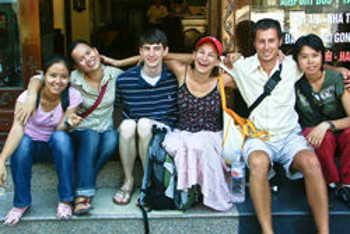 US-and-VN-College-StudentsHer smile erupted, and of course, Trang came to our nearby university - the same one where I had worked before my retirement. We watched in amazement as she amassed perfect grades and did advanced work few of her American fellow students would do. “Send me more Vietnamese students” was the comment I got from her department chair. Her advisor had to tell her to do less work on her Master’s thesis - her plan was more like a doctoral dissertation.
US-and-VN-College-StudentsHer smile erupted, and of course, Trang came to our nearby university - the same one where I had worked before my retirement. We watched in amazement as she amassed perfect grades and did advanced work few of her American fellow students would do. “Send me more Vietnamese students” was the comment I got from her department chair. Her advisor had to tell her to do less work on her Master’s thesis - her plan was more like a doctoral dissertation.
Our hopes were being fulfilled, but we found something unexpected happening to us as well. We found we had acquired a daughter - a daughter we never knew we needed. I already had a son - a good husband and father to his own family that I was very proud of, but having a daughter was different.
And I liked it.
Then the next year, Tuan came over. There wasn’t a PhD program for him at the local university, but there was the perfect program at a university just four hours north of us. Though he flew in to an airport far away from us, we were there to welcome him to America. With Trang in the car, we took the two on a trip through middle America before he settled in to his studies..
And Tuan took to calling Cindy “Mom”, though he had a perfectly wonderful Mom back in Huế. As time went by, more students came - Thanh, who had been Trang’s classmate, Ái Nhân (say Eye Nyun) had been my first year student, then finally Kien (say Kee unh), whom Ái Nhân married and brought back as her new husband and another grad student.
It was if we could no longer be in Việt Nam, so we brought Việt Nam to us.
There is something very strange in this story. Only the craftiest of fiction writers could have concocted a story where a wounded combat veteran returns to the land of his torment, only to fall in love with the country and its people. Stranger still that he would regard the former students who came to America as his gift! I suspect God had a big hand in the story plot, and I feel quite sure He has a smile on His face.
I try to convey that idea - the idea that Cindy and I have been very blessed by our experiences during Vietnam the war and in Việt Nam the country. In my book, I’ve written a story that is still unfolding - a story of redemption and love.
Thanks, God - I am blessed.
----------------------------------------------
Doug Young is the author of “Same River, Different Water: A Veteran’s Journey from Vietnam to Việt Nam,” available at online booksellers and on order at local book stores. The book includes 123 of the author’s photos. His wife Cindy is also a veteran of the Vietnam war, having served as a nurse at an Army hospital. Readers can contact Doug at This email address is being protected from spambots. You need JavaScript enabled to view it." mce_' + path + '\'' + prefix + ':' + addy90150 + '\'>'+addy_text90150+'<\/a>';
//-->
or on Facebook at http://www.facebook.com/doug.young.180
- Details
- Written by Doug Young
- Parent Category: Life and Style
- Category: Personal Development
by Doug Young
Part Two
Doug and Cindy Young, both veterans of the Vietnam War, returned to that country in 2005, to the city of Huế, where they taught English at the University for a year and half.
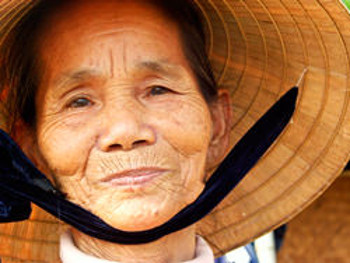 What these old eyes have seen! 1
What these old eyes have seen! 1
Outside of the teaching at the University, I found new friends of my own age. Mr. Phan Cu owned a small café dedicated to serving tourists - the Mandarin Café became my haunt after I found that Mr. Cu loved photography as much as I did. I learned much about the culture of Việt Nam from this English-speaking man who had worked for the Americans during the war. He and his wife Thanh’s first child was born just days after the fall of Huế in 1975 - in a hospital with no doctors or nurses, just abandoned birthing rooms. Life was hard for Cu during the decade of despair after the war, but today, this member of the new Vietnamese middle class freely tells any questioner that the war is long over and the Vietnamese have moved on.
It was Cu who showed me there were a few artifacts around from the war - but they weren’t obvious. I usually ate western food at his Mandarin Café and when eating western food, I used western eating utensils. The spoons and knives at the Mandarin were the usual tinny items found in most backpacker cafes, but the forks were solid. Cu had bought them in a village market years before. They were from an old American Army mess hall. The spoons and knives had been sold out, but since the Vietnamese don’t eat with forks, there were lots of these left in the vendor’s shop. Sure enough, many of the forks at the cafe were stamped “US Army” on the back.
And Cindy began to use her medical knowledge to teach English medical terminology classes to the physicians and nurses of the Huế Hospital. More friends were made - deeper roots were grown. I grew my own roots by photographing the wonderful people of the area - city folk and countryside peasants alike.
Time caught up with Cindy and me, and I knew I had to return home to care for my elderly mother, who was in the early throes of Alzheimer’s disease. But before we left, we got to know a young couple in Huế. James Sullivan and his Vietnamese wife Thuy (pronounced Twee) split their time between Huế and the US. We occasionally accepted dinner invitations to their home. Though far too young to be a veteran himself, Jim was fascinated that two American war veterans would actually live and work in the land where they had almost died. A professional journalist, Jim offered to edit my writing if only I would tell the story.
I protested - “Jim, I’m a photographer, not a writer.” But during many visits back to Huế, we kept meeting - and he kept pestering. On still another visit when the women were in the kitchen and the men in the living room, I agreed to write “Same River, Different Water: A Veteran’s Journey from Vietnam to Việt Nam.”
But the book has not been the only product of our time in Việt Nam. Remembering those bright students we had and thinking that I didn’t want those remarkable young minds to go to waste in the backwards Vietnamese higher education system, Cindy and I began bringing them to America for graduate work. Trang was the first - and she became the daughter I never knew I needed. Our love story with these remarkable Vietnamese young people continues in the next posting.
In the meantime, readers who wish to contact the author can find him at This email address is being protected from spambots. You need JavaScript enabled to view it." mce_' + path + '\'' + prefix + ':' + addy65559 + '\'>'+addy_text65559+'<\/a>'; //--> or on Facebook at http://www.facebook.com/doug.young.180. “Same River, Different Water: A Veteran’s Journey from Vietnam to Việt Nam” is available online at various booksellers such as Amazon or Barnes & Noble, or by ordering through your local bookstore.
BIO:
Doug Young met his wife, former Army nurse Cindy Mason, in Vietnam in 1969. After a successful career in law enforcement and higher education, Doug and Cindy retired early and moved to the city of Hue, Vietnam, in 2005, where they taught English at the University of Hue for a year and half. They enjoy their two cats, four grandchildren and one great grandchild as they also enjoy former Vietnamese students whom they have brought to the US for further study. Cindy and Doug live in south Texas.

True or False
The Pope’s Election
There were two Catholic boys, Timothy Murphy and Antonio Secola, whose lives paralleled…Glades County Pilot Sees Trailer Being Stolen From His House.
An article on news-press.com caught my eye today. It says that a North Carolina pilot,…Sinking of the TITANIC
On the 100th anniversary of the sinking of the Titanic in which 1,509 people died and…What Women Want
What Women Want in a Man When they first start dating 1. Handsome 2. Charming 3.…Eating Tips for the Christmas Holidays
1. Avoid carrot sticks. Anyone who puts carrots on a holiday buffet table knows nothing…I’ve got a bad cold or is it Man Flu?
Bob Tallent Thursday 8th December 2011 I picked up a bad cold last Monday. It’s now…Answers to Brainteasers
The Questions to these answers are in the previous article Answer 1 The base word is…Brainteasers
The answers to these teasers are in the next article Question 1 There is a common English…























